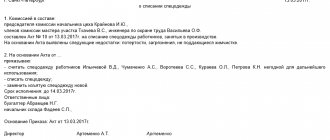Standards for issuing protective clothing to workers
In Russia, the period of use of work uniforms at enterprises is regulated by the Labor Code (Article 221). The document regulates the employer’s obligation to issue protective uniforms to employees free of charge and in a timely manner if production conditions require it. According to the Labor Code, each employee is entitled to a set of clothing and the necessary personal protective equipment, the choice of which depends on the nature of production and environmental conditions at the workplace.
Each labor sector has its own standards for free provision of work uniforms. They are approved in orders of the Ministry of Labor, as well as the Ministry of Health and Social Development. However, even within the same work activity, these standards may differ, focusing on professional responsibilities and position. For example, auxiliary workers are provided with 12 pairs of gloves per year, and for engineers and foremen, 3 pairs of gloves are issued for the same period.
General principles for writing off workwear in an organization
The write-off of workwear is subject to a certain procedure. First, protective kits are subject to inventory, during which the number of kits in kind and according to accounting data, actual and standard service life are compared, the quality of protective clothing, the possibility of further use, and the possibility of using waste after write-off are assessed.
Based on the results of the inventory, a write-off act is drawn up, which is signed by the commission and subsequently approved by the manager.
Workwear is written off according to the standards established by the organization. Their calculation is made on the basis of the Rules of the Ministry of Social Development No. 290n dated 01/06/09, which regulate the issuance of special clothing to employees at the intersectoral level. According to this document, issuance standards can be applied:
- standard (Order of the Ministry of Labor No. 997 dated 09/12/14);
- industry-specific (each industry has its own regulatory document);
- adopted in the organization based on the decision of the manager.
The administration has the right to establish increased standards for the issuance and write-off of workwear, but they must be justified (clause 6 of intersectoral rules No. 290n) by a special independent assessment of working conditions and reflected in the LNA. Arbitrarily established increased standards for write-off of workwear may cause a conflict with regulatory authorities. The Ministry of Finance also reminds of the need for an independent assessment (Letter No. 03-03-06/1/59763 dated 11/25/14).
https://youtu.be/C8UQfJtfmB4
Terms of use of workwear
The frequency of issuance of personal protective equipment and work uniforms depends on a combination of several factors:
- specifics of production and the level of health harm in the workplace;
- weather conditions and temperature conditions in production.
Most protective clothing for workers is issued for 1 year. The annual set of clothing that protects personnel from industrial pollution, depending on the profession, includes:
- robe;
- costume;
- overalls;
- apron;
- rubber boots;
- clogs;
- shoes with special protective properties.
For PPE, the standards and terms of use are determined based on the characteristics of the industry and professional responsibilities. For 1 year, 12 pairs of gloves with a protective coating are issued. Other personal protective equipment is used until worn out. PPE such as goggles, sleeves, elbow pads, and signal vests are used until they become unusable. After which the employee receives a new set.
An exception may be cases where employees work in particularly hazardous conditions. Then managers have the right to set their own standards for the use of workwear. At the same time, it is impossible to extend the service life of clothing and PPE. Improved standards are fixed in a collective agreement, which indicates the original standard standards and current changes.
What affects the service life of workwear
The service life of workwear, in addition to what is determined by the standards, largely depends on a number of factors:
- The quality of things. The requirements for clothing of this type are strictly regulated, however, cases are different - there is simply a factory defect or unscrupulous suppliers and the uniform will last less.
- Be careful during the period of use of workwear . Some people themselves are more thrifty and their things last longer. Proper care also has a significant impact: selection of suitable detergents, correct washing mode, etc.
- Choosing the right type of workwear . For each profession there is a specific form that is optimally suited to the activity being carried out.
Therefore, in order to buy a work uniform that will be as efficient, reliable and of high quality as possible, sometimes you have to look at more than one offer. Typically, competent, experienced companies immediately note all the features of their products. For example, they write about the service life of workwear (standards, GOSTs complied with, etc.) of a particular type - often the data is provided by the clients themselves in reviews.
Lifespan of winter workwear
Different terms for the use of clothing are established for employees whose work is associated with special temperature conditions (road workers, security guards). During the cold season, winter overalls are required: a warm jacket, pants or overalls, winter shoes (felt boots or boots). How much winter clothing is issued to security guards, construction workers, and road workers depends on the climate. Categories of climate zones (5 in total) are divided according to average temperature and wind speed in winter.
| Climate zone | Air temperature | Wind speed | Lifespan of winter clothing |
| 1 category | -1°С | 2.7 m/s | Jacket and trousers are issued every 3 years, shoes - every 4 years |
| 2nd category | -9.7°C | 5.6 m/s | Clothes are replaced every 2.5 years, boots - every 3 years |
| 3 category | -18°С | 3.6 m/s | Clothes are replaced after 2 years, shoes - after 2.5 |
| 4th category | -41°С | 1.3 m/s | The jacket and trousers are replaced after 1.5 years, boots - after 2 |
| Special category | -25°С | 6.8 m/s | Replacement is similar to the previous point. Additionally, the employee is provided with a sheepskin coat (4 years), a hat (3 years) and warm mittens (4 years) |
Winter workwear is issued only for the corresponding season. After the winter period, it is handed over for storage to the responsible department of the enterprise, for example, to a warehouse. The employer is responsible for storing seasonal clothing for employees. It is worth considering that specific temperature conditions mean not only the winter period.
Also, when issuing workwear, the microclimate in production is taken into account. At low temperatures there is a need to use warm protective clothing. For example, employees of food industry enterprises that use refrigeration units must be provided with appropriate insulated clothing: jacket, vest, trousers and shoes.
The procedure for providing workers with personal protective equipment
The employer guarantees that employees must use PPE in accordance with the Regulations on the Occupational Safety and Health System (OSS). Employees are not allowed to perform work without PPE issued to them in the prescribed manner, or if it is faulty, not repaired and/or dirty.
The issued workwear must be specially registered and controlled by the employer. For this purpose, a personal card is created for each employee in the form specified in the Appendix to Order 290n. Such an account card can be developed by the organization independently. It should contain the following information:
- date of issue;
- return date;
- wear percentage;
- signatures of the employee and the person responsible for accepting PPE from the employee.
In some cases, the type of PPE may not be specified in the relevant standard standards (we are talking, for example, about signal vests, balaclavas, mittens, etc.). In such cases, they are issued to employees with a service life “until wear out” or as duty workers based on the results of certification of workplaces for working conditions, as well as taking into account the conditions and characteristics of the work performed. Duty PPE for general use is issued to employees only for the duration of the work for which they are intended. Such PPE, taking into account the requirements of personal hygiene and the characteristics of workers, is assigned to certain workplaces and transferred from one shift to another. They are issued under the responsibility of the heads of structural units authorized by the employer to carry out such work.
Workwear intended for use in special temperature conditions caused by periodic seasonal temperature changes is issued to employees once a year, with the onset of the corresponding period, and at its end they are handed over to the employer for organized storage until the next season. The service life includes the time of their organized storage.
Workwear returned by employees after the wear period has expired and is suitable for further use is used for its intended purpose after taking measures to care for it. The suitability of the specified PPE for further use, the need for and the composition of measures to care for them, as well as the percentage of wear are established by an official authorized by the employer or the labor protection commission of the organization (if any) and are recorded in the personal record card for issue.
When issuing special protection, the use of which requires practical skills from workers (respirators, gas masks, self-rescuers, safety belts, mosquito nets, helmets, etc.), the employer must provide instructions on the rules of its use, the simplest ways to check functionality and serviceability, and also organize training by application.
How long will high-quality winter workwear last?
In order for winter workwear to last the specified period, it must be made of high-quality materials. In the manufacture of winter jackets, suits and overalls, natural breathable fabrics are often used, which reliably protect workers from cold, wind, precipitation and dirt. Such work clothes do not restrict movement, which is very important for the safe operation of personnel.
Most winter products are made from mixed fabrics, which significantly improves the performance characteristics of the clothing. This material allows air to pass through well, does not lose its shape after numerous washes, and is highly durable. When sewing winter workwear, reinforced threads are used, which perfectly protect clothes from mechanical abrasion, and special impregnation gives the products waterproof and dirt-repellent properties.
← Back to list of materials
The procedure for issuing and returning workwear
Issue
The employer must issue protective clothing according to the standard standards that are provided for his type of activity. 5, 14 Rules No. 290n. Only if the professions or positions of your employees are not included in the relevant standard standards, workwear is issued according to the standards for cross-cutting professions (positions) of all sectors of the economy, approved. By Order of the Ministry of Labor No. 997n.
You will find standard standards for the free issuance of special clothing, special footwear and other personal protective equipment to employees: section “Legislation” of the ConsultantPlus system
And if in these standards the employer does not find the corresponding professions (positions), then you need to be guided by the standard standards for workers whose professions (positions) are typical for the work performed by your employees.
In addition, the employer can establish its own standards for issuing workwear, but on the condition that they improve the protection of workers compared to the standard ones (for example, they provide a higher quality of protection), etc. 6 Rules No. 290n. Your own increased standards must be approved by order (or other local regulatory act).
WE TELL THE MANAGER
When the employer decides which employees (for which profession or position), in what quantity and for what period of time it is necessary to issue protective clothing, it is advisable to record all this in a local regulatory act, for example, in the regulation on PPE.
The employer must also organize records of the issuance of workwear and control over this process. Thus, its issuance is recorded by the responsible person in the personal card for recording the issuance of PPE.
The form of the card is given in the appendix to the rules for providing workwear. 13 Rules No. 290n; clause 61 of the Methodological Instructions, approved. By Order of the Ministry of Finance dated No. 135n (hereinafter referred to as the Guidelines). In this case, workers must sign for the receipt of special clothing. But in practice, there may be other ways to record its issuance and return, the main thing is that this process is controlled by the employer.
And further. The employer must not only provide workers with special clothing in a timely manner, but also ensure its storage, dry cleaning, washing, drying, repair and replacement. 3 tbsp. 221 Labor Code of the Russian Federation; clause 30 of Rules No. 290n.
Return of PPE
The owner of the workwear is the employer, and the employee only uses it. Therefore, the employee must return it. 64 Guidelines:
- <or> upon dismissal;
- <or>when transferred to another job where wearing special clothing is not required;
- <or>at the end of its wearing period, replace it with a new one.
If the returned workwear is suitable for further use (this must be determined by the labor protection commission or, in its absence, an official authorized by the employer) even after the end of the wearing period, after washing (or cleaning, disinfection, repair) it can be reissued to the employee and used further as directed. 22 Rules No. 290n.
At the same time, the employer must ensure that employees are notified of the procedure for handing over (returning) workwear. To do this you can:
- <or>prescribe in the regulations on PPE the procedure for returning workwear and familiarize them with it under the personal signature of employees;
- <or> include in employment contracts a condition on the return of protective clothing or its cost to the employer upon dismissal.
The return of workwear must also be reflected in the personal PPE issuance record card. 13 Rules No. 290n.
Workers of which professions are given winter workwear?
Standards for issuing workwear are established for each industry by separate Resolutions of the Ministry of Labor. In addition, there are documents at the regional level for the issuance of winter workwear. Federal documents have been adopted by industry, and therefore the employer must take into account all working conditions, climate zones and control the implementation of the relevant documents as much as possible. The table shows the main professions by climate zone:
The standards also stipulate that employees performing their duties indoors are not provided with insulated workwear. Depending on the region, additional clothing items may be provided, such as a hat with earflaps or felt boots.
Establishment of the period: “until wear”
As already mentioned, some personal protective equipment is issued to the employee “until worn out.” This list includes a signal vest, the service life of which is unlimited, safety glasses, noise-cancelling headphones, knee and elbow pads, some types of support belts, etc. The issuance of new PPE is provided only in the event of loss, theft, breakage, obsolescence and beyond the operational time frame , installed by the manufacturer.
Sample order for standards for issuing workwear
Thus, for example, if for supporting belts GOST provides for maximum use for a period of up to 25 years, then if during this time it has not become unusable, it is in any case subject to write-off.
In addition, the employer must conduct regular inspections of personal protective equipment. The enterprise must have a log in which each inspection will be recorded.
Additional Information! Typically, for long-life PPE, inspections are carried out every six months or a year.
How to determine for accounting purposes the wear period of workwear if the issuance rate is set “until worn out”
Any wear time can be set for items of equipment, the main thing is that it does not exceed the standards for maximum use of the product by GOST or the manufacturer of the product.
For example, the useful service life of safety glasses can range from a couple of months to 20 years. Therefore, for accounting purposes, it is possible to establish a systematic write-off every year, referring to the conditions of the work performed.









